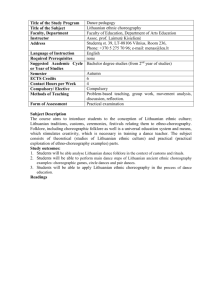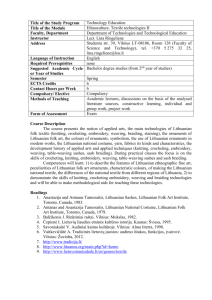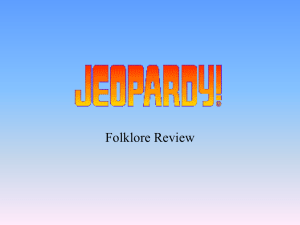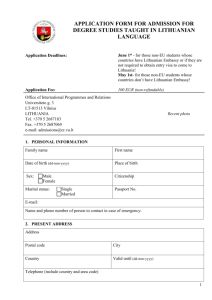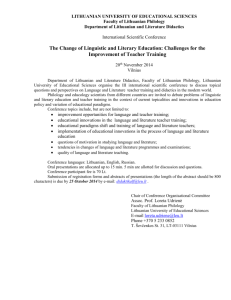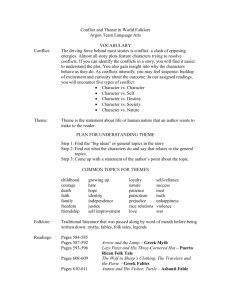P. Dundulienė – a researcher of symbolism in Lithuanian folk art The
advertisement
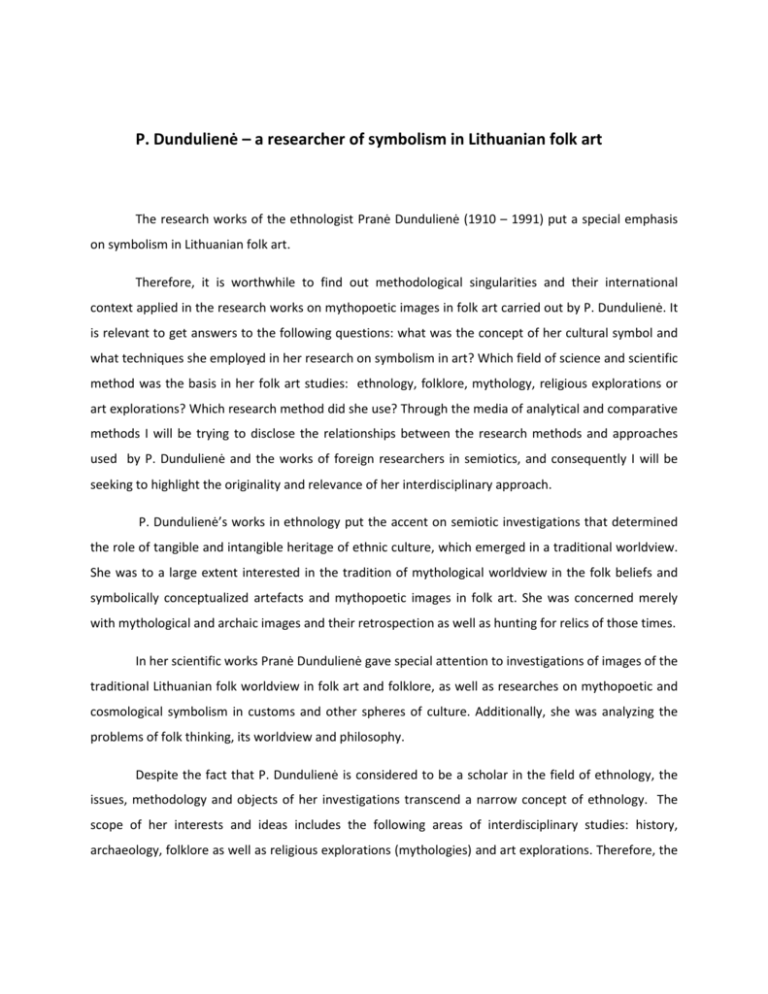
P. Dundulienė – a researcher of symbolism in Lithuanian folk art The research works of the ethnologist Pranė Dundulienė (1910 – 1991) put a special emphasis on symbolism in Lithuanian folk art. Therefore, it is worthwhile to find out methodological singularities and their international context applied in the research works on mythopoetic images in folk art carried out by P. Dundulienė. It is relevant to get answers to the following questions: what was the concept of her cultural symbol and what techniques she employed in her research on symbolism in art? Which field of science and scientific method was the basis in her folk art studies: ethnology, folklore, mythology, religious explorations or art explorations? Which research method did she use? Through the media of analytical and comparative methods I will be trying to disclose the relationships between the research methods and approaches used by P. Dundulienė and the works of foreign researchers in semiotics, and consequently I will be seeking to highlight the originality and relevance of her interdisciplinary approach. P. Dundulienė’s works in ethnology put the accent on semiotic investigations that determined the role of tangible and intangible heritage of ethnic culture, which emerged in a traditional worldview. She was to a large extent interested in the tradition of mythological worldview in the folk beliefs and symbolically conceptualized artefacts and mythopoetic images in folk art. She was concerned merely with mythological and archaic images and their retrospection as well as hunting for relics of those times. In her scientific works Pranė Dundulienė gave special attention to investigations of images of the traditional Lithuanian folk worldview in folk art and folklore, as well as researches on mythopoetic and cosmological symbolism in customs and other spheres of culture. Additionally, she was analyzing the problems of folk thinking, its worldview and philosophy. Despite the fact that P. Dundulienė is considered to be a scholar in the field of ethnology, the issues, methodology and objects of her investigations transcend a narrow concept of ethnology. The scope of her interests and ideas includes the following areas of interdisciplinary studies: history, archaeology, folklore as well as religious explorations (mythologies) and art explorations. Therefore, the issues highlighted by the scientist, the selected objects and methods used for their analysis were similar to the approaches developed by Western scientists. Pranė Dndulienė did not discuss about the methodology of her research works and theoretical approaches in more detail. P. Dundulienė did not establish an original research methodology of her own – in part, she synthesized experiences of several schools. Due to an insufficient accuracy of her scientific works, occasional absence of convincing arguments and the lack of theoretical and methodological clarity and coherence, P. Dundulienė’s opponents did not acknowledge the strengths of her research works – complexity and interdisciplinarity that transcended a narrow historical-ethnological approach, which was a characteristic feature in a number of works of ethnographers of those times. P. Dundulienė’s opponents failed to distinguish the relationship between her research works and a broader context of problems and issues of science existing in neighbouring countries and the world. Essentially, the works of P. Dundulienė were assessed according to narrowly perceived criteria1 on ethnography as a branch of history (that explores the peasant way of life, their daily life, holidays and economics in a short span of a few hundred year historical perspective). Despite some weakness, incompleteness and inconsistency or the lack of reference sources, the works of P. Dundulienė revealed a possibility and expediency of using various research methods in ethnology. Her investigations synthesized the data of such branches of science as ethnology, folklore/mythology, history, archaeology and art history, and consequently combined the methods that were applied in interdisciplinary studies. Considering the fact that the scientist took an interest in ideological and symbolic aspects of culture, it is not surprising that titles of most of her works are more suitable for publications on art history, religious explorations or folklore. These include: “Eyes in the Lithuanian Folk Worldview” (1977), “The Grass-Snake and its Symbols in Lithuanian Folk Art and Creative Works of Verbal Art” (1979), “Birds in the Beliefs of Ancient Lithuanians and in Art” (1982), “Fire in the Lithuanian Folk Worldview” (1985), “Lithuanian Folk Cosmology” (1988), The Ancient Lithuanian Mythology and Religion” (1990), ,”The Tree of Life in Lithuanian Art and Folklore” (1994). P. Dundulienė was a witness of proximate relationships between Lithuanian ethnology and art explorations and museology, and similarly she was a participant of the problematic development process that eventuated at Vilnius University in the post-war period. In 1945, shortly after completing her studies in ethnology at S. Batoras University, with the assistance of J. Baldžius , she established the Department of Ethnography at the restored Vilnius University, where she worked for the rest of her life. When the art critic P. Galaunė proved the significance of museology for Lithuanian science, in 1947 this Department was reorganised into the Department of Museology; P. Galaunė was appointed Head of the Department. A. Mikėnaitė started teaching folk art. Unfortunately, in 1951 P. Galaunė was dismissed from work due to an unacceptable ideological orientation - propagation 2 of Čiurlionis’ creative works that involved symbolism and idealism; the latter Department was reorganised into the Department of Archaeology and Ethnography accordingly. The liberation of scientific thought in the Soviet Union after the end of the Stalin era primarily affected Russian science (occasionally, researches on spiritual culture were carried out there); this could be traced in major theoretical and methodological approaches that were applied by P. Dundulienė. It should be noted that P. Dundulienė’s folk art research methods were focused not merely on the works of ethnologists but also on folklorists, linguists, archaeologists and the scholars of religion. Essentially, that was in line with the revival of semiotic studies in the Soviet Union, firstly in the fields of folklore, language, literature and archaeology. She started to refer to the works of such authorities as V. Ivanovas and V. Toporovas3 , V. Toporovas4 and B. Rybakovas5 likewise L. Šternbergas6, I. Gurėvičius7 and D. Zeleninas8. It is important to remember that P. Dundulienė was one of the few Lithuanian ethnologists who managed to get away from researches on the collective farm reality of those times, except when it benefited to the issues of her own research (e.g., the chapter of the publication about bread9 “Bread in Customs of the Soviet Times“). Uniqueness of P. Dundulienė’s methods was revealed through her efforts to investigate not merely the history of ethnic culture and its traditions but also (especially in folk art) their contemporary interpretations (e.g., the following chapters: “Grass-Snakes in Professional Art and the Works of Verbal Creation“10, ”Birds in Professional Art and Fiction“ 11); this helped approach to the problems of art explorations. P. Dundulienė developed ethnology, which was based not merely on field studies and ethnographic data collection. Seeking to reveal the meanings of folk culture symbols, she used to examine separate specific objects and consequently, she came closer to the spheres of researches on ideology and creative works: the paradigms of art history, religious explorations, mythology and folklore likewise other fields of science that investigated cultural semiotics, approaches and research methods, including reconstruction. As maintained by P. Dundulienė, the key object of her research was considered to be the folk art segment; moreover, she applied methods that were typical to semiotic researches on narrative and visual arts (J. Basanavičius, V. Mansika12, D. Zelenin, B. Rybakov, A. Afanasjev13, V. Propp, L. Šternberg, M. Gimbutienė, V. Toporov ir V. Ivanov, M. Eliade, A. Gurėvič14). To some degree, P. Dundulienė was a successor of J. Basanavičius’ approach that involved hunting for the origins of archaic and mythical folk art symbols through correlating the data of folklore, customs and archaeology as well as accurately comparing them with the data 15 of other cultures that was collected at different periods of time. P. Dundulienė was well aware of the works 16 of L. Šternbergas – a Jewish ethnologist from Russia, non-Marxist classic and evolutionist who extensively investigated the mythical worldview of Siberian peoples and who was criticised by the Soviet historians due to some implications of the idealistic worldview. The school that best matched the spirit of P. Dundulienė was Tartu – Moscow Semiotic School, the representatives of which were involved in an in-depth-study of semiotics of traditional culture images of mythic origin in Eastern Europe and developed typological, historical, contextual and comparative research methodologies on symbols of the mythic worldview. Her predecessors were Russian linguists, mythologists, folklorists and literary critics (V. Propp, O. Freidenberg) likewise cultural anthropologists and aesthetes (S. Eizenštein, M. Bachtin, L. Vygodskij). P. Dundulienė referred to the works of V. Toporovas and V. Ivanovas pretty frequently. The latter authors developed structuralist semiotics in their researches on culture, folklore and linguistics. V. Toporovas and V. Ivanovas focused their attention on the structural semiotics analysis and interpretation17 of the facts of traditional culture of the Balts. The works of the Russian archaeologist and academician B. Rybakovas (Рыбаков 1965), namely his interpretations on cosmological symbolism of the pottery decor of the Neolithic era (Ukraine), were influential to P. Dundulienė. The author (B. Rybakovas) related archaeological materials to the mythological data of other cultures that were existing in approximate periods of time, and discovered their similarities with folk art symbolism of Eastern European nations, their ethnography and folklore. B. Rybakovas was well aware of M. Gimbutienė’s research works. P. Dundulienė referred to the works of M. Gimbutinė, especially to the approach regarding her research on cosmological folk art symbolism of the ancient Balts and Lithuanians of the 19th century as well as correlations drawn between folk art data and particularly extensive comparative mythology and art materials 18 on ancient civilizations. Similarly to Gimbutienė, the scientist was seeking to bound the approaches of an ethnologist, folklorist-mythologist, archaeologist and historian, combine the data in archaeology, religious explorations, Lithuanian mythology and folklore, and apply comparative and contextual methods and the methods of historical analogy as well as hypothetical and interpretive reconstruction. P. Dundulienė’s works were based on Gimbutienė’s perceptions, regardless the fact that her works have long been inaccessible to Lithuanian science due to the ideological censorship. The comparative approach of M. Gimbutienė, that is, interpretations of typological interfaces of visual symbolism and their relationship with mythologemes and universal symbolism 19 of mythic images were related to the approaches20 of the American mythologist and comparativist - Džozefas Kempbelas (Joseph Campbell) – one of the most famous researchers of archetypical mythic images of the 20th century, who was in close contacts with M. Gimbutienė. P. Dundulienė, as the successor of Gimbutienė, synthesized, correlated and generalized different data on customs, beliefs, folklore, mythology and art that involved similar symbols; moreover she thoroughly explained cosmological folk art symbolism and the foundations of the archaic traditional mythological Lithuanian worldview. P. Dundulienė’s perceptivity concerning the relationships between roof-poles and the symbolism of the Tree of Life matches not merely with the findings of M. Gimbutienė and N. Vėlius21, but also with the conclusions 22 contained in other contexts of intercultural researches made by the Canadian cultural anthropologist J. Vaštokienė. P. Dundulienė drew special attention to the archaic folk art symbolism, pre-Christian mythic worldview, mythology of the Balts and Lithuanians (the concept of folklore) and its tradition. A distinctive feature of most of her works is searching for archetypes. Through explaining and interpreting traditions – customs, beliefs and worldviews - she was trying to describe their ideal and typical patterns as the symbols of national identity. She was neither interested in distinctive and singular features of ethnographic data collected in different locations of Lithuania, nor was she going deeper into the problems of regionalism. She was concerned about the manifestation of hermeneutical, universal and archetypical aspects in thinking and the worldview of people of traditional culture. She was original in analyzing Lithuanian identity as the embodiment of the following archetype: nation-tribe-family- ancestors. She paid her considerable attention to the archetypes of archaism as well as the paganism of the Balts (or cosmology as its element) and ancient Lithuanians. This is reflected in the titles of her works that sound mythological and poetic: “Paganism in Lithuania” (1989), ”Lithuanian Folk Cosmology“ (1988), “Trees in the Beliefs of Ancient Lithuanians“ (1979) and “Ancient Lithuanian Mythology and Religion“ (1990). She was concerned about the means of expression for birds, grass-snakes, trees, bread, an eye, the earth, the fire, the Tree of Life, celestial luminaries and space phenomena likewise other archetypes that were considered ideal patterns and semantic universalities in Lithuanian ethnic culture. Consequently, she studied the images of water and mythical personages (especially females) of the Pre-Christian origin as well as the attributes of different customs and artefacts (e.g., Easter eggs, gloves, the dowry chest decor, the upper part of iron crosses etc.) that were considered symbols 23 of mythological poetic images. P. Dundulienė’s attitude toward ethnic culture as a syncretic complex phenomenon, which could be studied through distinguishing separate areas of semantic themes, e.g., describing the Tree of Life that covers all the spheres of the World - vertical, horizontal and time dimensions as well as their separate elements: the sky (cosmology), the air (birds), the earth (horses), the vault (grass-snakes and other reptiles) - demonstrate her relationship with structural semiotics. Her major viewpoints are similar to M. Eliadė‘s searches for universalism of mythical worldview, T. Gamkrelidzė and V. Ivanovas’ approach determining the common Indo-European field of archaic mythological-poetic images likewise the reviving process of compilation of the common Lexicon on Semantics of Pro-Indo-European culture. Gamkrelidzė and V. Ivanovas proved that it was possible to reconstruct the Indo-European worldview on the basis of folklore and written sources. This is apparent in the following chapters of their work “IndoEuropean Languages and Indo-Europeans,”: “Living Creatures of the Vault: The Main Myth about “the Snake” in “the Indo-European Mythology”, “Names of Domestic Animals of Indo-Europeans”; “Farming Purposes of Domestic Animals of the Ancient Indo-Europeans and their Cult-Ritual Functions: From a Ritual Point of View, Animals are Close to Human Beings: “The Cult 24 of the Horse in the Ancient Culture of the Balts”. P. Dundulienė‘s concept on multistageous cultural phenomena that approved the existence of elements of the previous ideological systems in the subsequent cultural phenomena, was well-known to most researchers in folklore, mythology and art history. This concept has been acknowledged by V. Bagdanavičius25, M. Gimbutienė, A. J. Greimas and V. Toporovas likewise. The systems of mythical approaches and searching for their relics in the phenomena of ethnic culture as well as their historical retrospection that caught P. Dundulienė‘s attention, were the media enabling to reconstruct Lithuanian mythological worldviews. In addition, her investigations are indirectly related to the objectives concerning national identity likewise searching for the signs of ethnic symbolism and their design. The author was interested in the symbols that, in her opinion, were the most important, distinctive and viable articles of the national culture. Since the written sources on the Lithuanian Pre-Christian culture and people’s mentality were relatively modest – she tried to use ethnographic data as a cultural memory and verbal sources of history that were meant for “rehabilitating” and actualizing the memory of the Lithuanian Pre-Christian culture. These aspirations helped her transcend a narrow ethnological approach and bring her viewpoints closer to mythology and ethno-semiotics. Thus, when at the beginning of her scientific career P. Dundulienė familiarized herself with distinctiveness of Lithuanian School of Ethnology - namely its resilient relationships with art explorations, archaeology and museology - she developed this concept in her subsequent research activities. She used research methodologies that were characteristic not merely to ethnology, as a branch of history; she also developed an interdisciplinary approach, applied the methods of folklore, art explorations, religious explorations and cultural anthropology as well as expanded the network of semiotic and comparative researches. Since her major concern involved searching for mythological-poetic images and constructs in ethnic culture, she maintained the approaches that were dominant in Tartu-Moscow Semiotic School and the Russian School on Folklore and Ethno-Mythology Studies. Furthermore, she used M. Gimbutienė’s methodology on the analysis of visual semiotics, which was in part intercepted from the mythologist-comparativist J. Campbello, who was considerably impressed by C. G. Jungas ideas. P. Dundulienė maintained the methodology of the archaeologist B. Rybakovas which he applied in his research on ancient images, when the meaning of a symbol was analyzed through comparing and correlating the data on archaeology, folklore and ethnology that was collected at the same territory at different periods of time. Čiubrinskas, V. Sovietmečio iššūkiai Lietuvos etnologijai: disciplina, ideologija ir patriotizmas, Lietuvos etnologija: socialinės antropologijos ir etnologijos studijos 1 [10], 2001, p. 100, 107-110; Mardosa, J. 1 Ikikrikščioniškosios kultūros interpretacijos Lietuvos etnologijoje, Lietuvos etnologija: socialinės antropologijos ir etnologijos studijos 1 [10], 2001, p. 119-124, 126, 128-129, 133-135, 137-140. Tumėnienė, N. Menotyros studijos Vilniaus universitete (1940-951), Meno istorijos riboženkliai/Landmarks of Art history. Meno istorija ir kritika/Art History and Criticism 7, 2011, p. 97-98. 2 Иванов В. В., Топоров В. Н. К семиотической интерпретации коровая и коровайных обрядов у белоруссов, Труды по знаковым системам 3. 1967. 3 Топоров, В. Н. О структуре некоторых архаических текстов, соотносимых с концепцией „мирового дерева”, Труды по знаковым системам 5, 1971, с. 9-63. 4 Рыбаков, Б. А. Космогония и мифология земледельцев энеолита. Советская археология 1, 1965, с. 24-47; Советская археология 2, 1965, с. 13-33. 5 Штернберг, Л. Я. Первобытная религия в свете этнографии. Ленинград: Изд-во Ин-та народов Севера ЦИК СССР им. П. Г. Смидовича, 1936. 6 Гуревич Ф. Украшения со звериными головами из Прибалтийских могильников (к вопросу о культе змеи в Прибалтике), Краткие сообщения о докладах и полевых исследованиях Института истории материальной культуры XV, 1947, с. 68–76. 7 Зеленин, Д. К. Тотемы-деревья в сказаниях и обрядах европейских народов. Труды Института антропологии, археология, этнографии: Этнографическая серия 5. Москва - Ленинград: Изд-во Академии наук СССР, 1937. 8 9 Dundulienė, P. Duona lietuvių buityje ir papročiuose. Kaunas: Šviesa, 1989, p. 113-116. Dundulienė, P. Žaltys ir jo simboliai lietuvių liaudies mene ir žodinėje kūryboje: mokymo priemonė. Vilnius: LTSR aukštojo ir specialaus vidurinio mokslo ministerija, Vilniaus V. Kapsuko universitetas, 1979. 10 Dundulienė, P. Paukščiai senuosiuose lietuvių tikėjimuose ir mene. Vilnius: LTSR Aukštojo ir spec. vid. mokslo m-jos Leidybinė red. Taryba, 1982. 11 Manskikka, V. J. Die Religion der Ostslaven. I. Quellen. Helsinki 1922 (Мансикка Вильо Йоханнес. Религия восточных славян. Москва: ИМЛИ им. А. М. Горького РАН, 2005). 12 Афанасьев, А. Н. Поэтические воззрения славян на природу. Мoсква, 1865-1869. (Москва: Современный писатель, 1995). 13 14 Гуревич, А. Я. Проблемы средневековой народной культуры. Москва: Искусство, 1981. Basanavičius, J. Iš krikščionijos santykių su senovės lietuvių tikyba ir kultūra: (prie studijos ,,Lietuvių kryžiai archaiologijos šviesoje”). Vilnius: M. Piaseckaitės-Šlapelienės knygyno leidinys, 1912; Basanavičius, J. Apie obuolį lietuvių dainose bei pasakose ir vestuvių apeigose, J. Basanavičius (red.), Lietuvių tauta: laikraštis skiriamas lietuvių praeities ir dabarties tardymui. Vilnius: Lietuvių mokslo draugija III, 1923, p. 402-411; Basanavičius, J. Dėliai Daidaliaus ir jojo labirinto. Vilnius, 1925. 15 16 Штернберг, Л. Я. Min veik. Иванов, В. В., Топоров, В. Н. Славянские языковые моделирующие семиотические системы: Древний период. Москва: Наука, 1965; Иванов, В. В., Топоров, В. Н. Структурно-типологический подход к семантической интерпретации произведений изобразительного искусства в диахроническом аспекте, Труды по знаковым системам 8, 1977, с. 103-120; Иванов, В. В. Отражение индоевропейской терминологии близнечного культа в балтийских языках, Топоров В. Н. 17 (ред.), Балто-славянский сборник. Москва: Наука, 1972, 193-205; Иванов, В. В. Проблемы этносемиотики, M. А. Сергеевич (ред.), Этнографическое изучение знаковых средств културы. Ленинград: Наука, 1989, c. 38-62; Топоров, В. Н. Заметки но балтийской мифологии, Балтославянский сборник, Москва: Наука, 1972, c. 290-309. 18 Gimbutas, M. The Ancient Symbolism in Lithuanian Folk Art. (Memoirs of the American Folklore Society: 49). Philadelphia: American Folklore Society, 1958. 19 Gimbutas, M. The Language of the Goddess: Unearthing the Hidden Symbols of Western Civilization. San Francisco: Harper & Row, 1989; Gimbutienė, M. Baltų mitologija. Senovės lietuvių deivės ir dievai. Vilnius: Lietuvos rašytojų sąjunga, 2002. 20 Campbell J., assisted by M. J. Abadie, The Mythic Image. Princeton, New York: Princeton University Press, 1974; Campbell J., Moyers, B. D. The Power of Myth. New York: Doubleday, 1988; Campbell, J. The Hero with a Thousand Faces. New York: Pantheon Books, 1949; Campbell, J. The Masks of God. New York: Wiking Press, London: Secker & Warburg 1-4, 1968. 21 Vėlius Norbertas. Senovės baltų pasaulėžiūra, Vilnius: Mintis, 1983. 22 Vastokas, J. M. The Shamanic Tree of Life, A. T. Brodzky, R. Danesewich, N. Johnson (eds.), Stones, Bones and Skin (Ritual and Shamanic Art). Toronto, Ontario: Society for Art Publications, 1977, p. 93117. Dundulienė, P. Akys lietuvių liaudies pasaulėjautoje, Istorija XVII (1). Vilnius: Vilniaus Universiteto leidykla, 1977; Dundulienė, P. 1979. Medžiai senovės lietuvių tikėjimuose. Vilnius: Mintis; Dundulienė, P. Lietuvių liaudies kosmologija. Vilnius: Mokslas, 1988; Dundulienė, P. Pagonybė Lietuvoje: moteriškosios dievybės. Vilnius: Mintis, 1989; Dundulienė, P. Senovės lietuvių mitologija ir religija. Vilnius: Mokslas, 1990; Dundulienė, P. Gyvybės medis lietuvių mene ir tautosakoje. Kaunas: Šviesa, 1994. 23 Гамкрелидзе Т. В., Иванов Вяч. Вс. Индоевропейский язык и индоевропейцы, Тбилиси: Издательтво Тбилисского университета 1-4, 1984. 24 25 Bagdanavičius, V. J. Kultūrinės gelmės pasakose. Vilnius: Taura, 1992.


